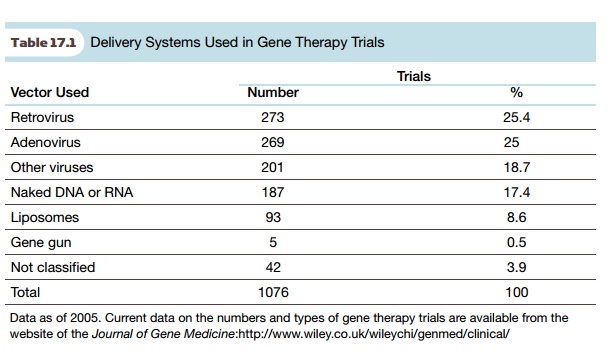Chapter: Biotechnology Applying the Genetic Revolution: Gene Therapy
General Principles of Gene Therapy
GENERAL
PRINCIPLES OF GENE THERAPY
The most straightforward use
of gene therapy is to deal with a hereditary defect due to a single gene and
that occurs only when both copies of the gene are defective—that is,
a recessive condition.
Introducing a single good copy of the gene can then cure the defect. This is
sometimes known as replacement gene
therapy. Furthermore, it would obviously simplify treatment if the disease
mostly affects just one or a few organs. The main steps involved in replacement
gene therapy are as follows:
(a)
Identification and characterization of gene
(b)
Cloning of gene
(c)
Choice of vector
(d)
Method of delivery
(e)
Expression of gene
The first step is to identify
the genetic defect and to clone a good copy of the gene involved. The gene must
then be delivered to the patient. This involves choosing a vector together with
a suitable method of delivery. In addition, the vector/gene construct must be
designed to allow proper expression of the gene, once inside the patient.
Delivery may be performed in a variety of ways. The vector/gene construct may
be injected into the bloodstream or other tissue. It may be aerosolized and
sprayed into the nose and airways. In some cases, cells are removed from the
patient, engineered while growing in culture, and then returned to the patient.
This approach is known as ex vivo gene therapy because the actual genetic engineering takes place
outside the patient. (The direct delivery of the vector/ gene construct to the
patient is sometimes called “in vivo
gene therapy” to contrast with this.)
In the laboratory, most manipulations are done with genes carried on bacterial plasmids. Although gene therapy has occasionally been performed directly with plasmid DNA carrying a therapeutic gene, more often specialized delivery systems are used. In most cases a modified virus is used as the vector. Because viruses cause disease, they first need to be genetically disarmed in order to be used in gene therapy. About 70% of human gene therapy trials have used viral vectors (Table 17.1). Two main groups of viruses have been used, retroviruses and adenoviruses. In addition, in a smaller proportion of cases DNA has been delivered inside liposomes or projected into tissues by the gene gun.

Related Topics